If you’ve explored modern cancer research, you’ve likely encountered the patient-derived xenograft (PDX) model. Rather than a buzzword, the PDX model represents a useful tool for testing therapies under conditions that resemble human tumors.
The PDX model allows researchers to observe tumor behavior in a living system and tailor treatments more effectively. Read on to learn how it works and what advantages it offers.
What Is a PDX Model?
PDX models (patient-derived xenografts) are research tools created by implanting human tumor tissue into immunodeficient mice. They allow human cancer cells to grow in an animal host without immune rejection.
Using mice that lack certain immune responses ensures the human tumor cells engraft and grow similarly to how they do in patients. This helps researchers study tumor growth, drug response, and biomarker profiles under near-clinical conditions.
In cancers like breast cancer, biomarkers, prognosis, and prediction data can be collected directly from PDX tumors to guide treatment decisions.
Key benefits of PDX models include:
- Different patients respond differently to therapies. PDX models provide biomarkers to predict individual drug response.
- Cancer recurrence is common. PDX-based testing helps select treatments that reduce the risk of relapse.
- Stakeholders—from oncologists to drug developers—gain data-driven guidance for personalized cancer care.
Although many compounds show promise in vitro, only a fraction succeed in vivo due to complexity in living systems. PDX models help bridge that gap by providing more predictive preclinical data.
Benefits of the PDX Model
Research indicates global cancer cases may rise to 35 million by 2025. Tools like PDX models help counter this trend.
Improves Predictions About Treatment Responses
Since patients vary in drug sensitivity, PDX models can indicate who may benefit from a given therapy and identify biomarkers of resistance or response.
Supports Drug Discovery and Development
Beyond matching existing treatments, PDX models are used to test new compounds and drug combinations for efficacy before clinical trials.
Enables Personalized Treatment Plans
By identifying a patient’s unique biomarker profile, PDX-guided testing helps clinicians choose therapies tailored to each individual.
Conclusion
PDX models represent a significant step forward in preclinical oncology. They provide a closer approximation of human tumor biology, helping researchers and clinicians develop more effective, personalized treatments.
While cancer remains a complex challenge, tools like PDX models offer a more data-driven approach that could improve outcomes for patients.
Prospect site: radiologykey.com
Landing page: https://www.championsoncology.com/solid-tumor-pdx-models
Keyword: pdx model
A Ray of Hope: Can the PDX Model Help Find a Cure for Cancer?
If you have been researching possible cures for cancer, you have indeed come across the PDX model. The PDX model is not just a term but a hope to find a cure for cancer. The patient-derived xenograft is a groundbreaking innovation in the field of healthcare.
The PDX model is a tool that enables patients and stakeholders to find the right solution for this malignant disease. It can closely monitor how the tumor behaves inside the human body and provide a personalized solution to each patient. Read this article to learn more about the PDX model and whether it’s a breakthrough.
What Is a PDX Model?
PDX models, or patient-driven xenografts, are laboratory tools used in cancer research. They are created by implanting human tumor tissue into immunodeficient mice.
Now, why an immunodeficient mouse? Doing so ensures that the animal accepts the human tumor cells, and the tumor grows inside its body. The cells work like they do in a human being, enabling researchers to understand how the cancer behaves inside the human body.
In cancers such as breast cancer, the biomarkers, prognosis, and prediction play a crucial role in the diagnosis and treatment, which can be easily collected with a PDX model.
A PDX model helps solve multiple prevalent problems in the medical realm.
- Different patients respond differently to other drugs. Hence, there is a growing need for biomarkers to understand how a patient will react to a particular drug.
- Cancer tends to recur. The PDX model helps provide guidance on which patients can benefit from which therapy, minimizing the chance of cancer returning.
- Stakeholders need guidance on how to proceed with cancer treatment for different patients. Even in this situation, the PDX model is deemed helpful.
Although there have been many developments in oncology, gaps still need to be filled. Some drugs have proven therapeutic in vitro efficiency, but only a few have been considered safe in terms of in vivo experiments. This problem is due to a lack of tools and genuine information. In such a scenario, the PDX model is a revolutionary innovation. The section below will look at how it benefits the oncology industry.
Benefits of the PDX Model
Research shows that by 2025, the total cancer cases in the world will increase to 35 million. Tools like the PDX model are weapons stakeholders can use to battle this growth.
Improves Predictions About Different Treatment Responses:
Different patients react differently to various drugs. A PDX model can help oncologists predict how an individual will respond to a drug and a treatment path. The model can also help identify biomarkers that indicate whether a person will react positively to a treatment or show resistance. All this information helps stakeholders make better decisions, impacting the overall improvement of patients’ health.
Helps in Drug Discovery and Development:
PDX models help identify the proper treatment for the patient. But did you know they also allow the testing of novel drugs? They help identify different combinations of drugs to determine their efficacy and subsequent reaction by the receiver.
Help Provide Patients With a Personalized Treatment:
Providing patients with personalized treatment is a must when they are battling cancer. With the PDX model, stakeholders can identify the biomarkers that predict the body’s resistance and response to a particular drug. This information helps experts find a treatment path that is specifically made for the patient.
Conclusion
The PDX model is a significant advancement in the field of oncology. It allows stakeholders to discover and develop drugs related to different types of cancers. This procedure includes closely studying the formation and development of cancer and determining the essential biomarkers that will make a huge difference.
Suffering from cancer is one of the roughest journeys in an individual’s life. Moreover, due to the unpredictable nature of the disease, it is difficult to find an appropriate solution. Fortunately, solutions like a PDX model offer hope.
Stay updated, free articles. Join our Telegram channel

Full access? Get Clinical Tree





